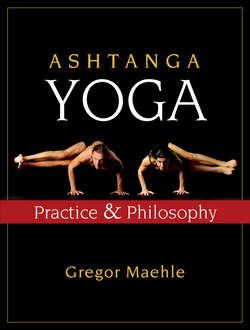Читать книгу Ashtanga Yoga - Gregor Maehle - Страница 81
На сайте Литреса книга снята с продажи.
Vinyasa One
ОглавлениеFrom Samasthiti, jump on inhalation and, exhaling, land with your feet parallel, hip width apart, placing hands on hips. “Hip width” means the ankle joints are positioned under the hip joints.
ANATOMICAL FOCUS
Disc Bulges
A disc bulge (see page 38) can occur when a weight is lifted off the floor with the spine flexed. Pressure on the discs between the vertebrae deforms them into a wedge shape and predisposes them to bulging. The intervertebral discs act as shock absorbers for the vertebrae. They consist of a fibrous band enclosing a fluid-filled nucleus. When this liquid-filled cushion is pushed beyond the boundary of the vertebrae, it is called a disc bulge. Often the disc will press against the spinal cord and cause considerable pain. The adjacent muscles spasm to arrest and thereby protect the spine, resulting in a complete inability to bend forward. A disc bulge usually corrects itself in a few weeks. A disc prolapse differs from this in that the fibrous nucleus of the disc is pushed beyond the boundary of the vertebrae. Allopathy6 considers that this condition does not repair itself.
It is therefore important to avoid rounding the low back when bending forward, as in this position it bears the weight of the body. Instead, bend the knees while still maintaining some stretch in the hamstring muscles.
Inhaling, grow the legs tall and strong, and lift the torso up and out of the hips. Exhaling, fold forward at the hip joints, keeping the back straight and the heart lifted. Reach for the toes, hooking the big toes with the first and second fingers, palms facing inward, and closing the clasp of the fingers with the thumb. Students who cannot yet reach their toes may bend their legs. Bending of the low back to reach the toes is not recommended, as this places pressure on the lumbar discs, and may cause them to bulge.
